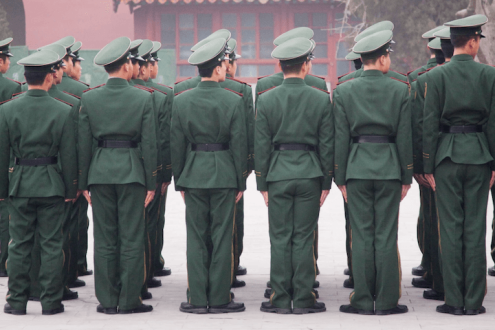Recent U.S. regulations have targeted the risks posed by Chinese military companies, including 31 companies designated by the Department of Defense under Section 1237 of the National Defense Authorization Act of 1999 and later named in Executive Order 13959 (“the Section 1237 list”).
These actions expand the definition of military affiliated entities in China, creating new compliance challenges.
We compiled a dataset covering more than 600 active legal entities that are majority owned by these 31 companies from the first three tranches of the Section 1237 list. (Note: 4 additional entities were added to the Section 1237 list on December 3 and will be included in future analyses.)
This analysis helps compliance teams quickly triage risk and understand the Chinese military’s ties to the civilian economy. For each entity, we provide the Chinese name, English name, machine translation, address, identifiers, operating status, ownership path, and a link to the expanded profile and sourcing in Sayari Graph.
Key Findings
- Many entities in our dataset have no obvious ties to the Section 1237 list. Over one-third have names entirely different from their designated parents. Many others reference their parents in ways that escape machine translation or are unclear to non-native speakers.
- Most entities in our dataset have no obvious ties to the military. Across 25,000+ holdings examined, less than 1% mentioned “military” or “Military-Civil Fusion” (MCF) in their names or business purposes. While consistent with China’s MCF strategy, this complicates compliance efforts.
- “Chinese military companies” own companies domiciled across the world. Many Section 1237 entities are major corporations with global footprints. Our data reveals dozens of foreign-domiciled holdings, including in the U.S., within three layers of ownership.
- This dataset represents a fraction of the high risk holdings of Section 1237 entities. We identified majority-owned subsidiaries of the first 31 listed entities using Chinese public records. There are likely many other entities that meet the majority ownership risk threshold or other high-risk criteria, like separately registered and non-obvious branches, that may be the subject of future analyses.
Methodology
Like most U.S. regulatory lists, Section 1237 and E.O. 13959 provide only English names. We first confirmed the Chinese legal name and unique ID for each entity using our database of Chinese public records.
Next, we ran a set of graph queries in our public records database starting from each Section 1237 entity and following all ownership links downstream. Capping results at three layers returned over 25,000 entities that were majority/minority owned by, subsidiaries of, or branches of the listed entities.
We focused on the highest-risk holdings: entities with direct or indirect majority shareholding by Section 1237 entities. Share percentages are not consistently disclosed in Chinese corporate records, so we calculated them from nominal values where possible, excluding relationships where both values were unknown.
We also included “subsidiaries” explicitly disclosed in China’s Ministry of Commerce Overseas Investment Database. This source defines subsidiaries as entities with over 50 percent shareholding by the parent entity.
The result is a dataset of over 600 legal entities that are majority owned by Section 1237 entities.
We enriched each entity with identifying information and other relevant attributes (e.g. operating status) from our database of Chinese public records, which consists of multiple records for each entity pulled from different public records sources. We assumed any entity marked “closed” in any filing was indeed closed.
We generated this dataset automatically using records collected over the past year (updated October 2020). While we performed automated checks and random sampling to confirm accuracy, always verify information with the original source.
Note: This dataset does not represent all high-risk entities; many others likely meet the risk threshold.
Finally, conflicts occasionally exist between primary registration records and annual reporting or other official sources.
Findings
Footprint in China and overseas
Many Section 1237 entities are massive corporations controlling hundreds of entities through multiple layers. Some, such as Huawei, have established and well-known overseas footprints.
Our data confirms this geographic reach. Within the 25,000+ total holdings examined, we identified over 700 entities domiciled in 34 other countries, including some domiciled in both China and the United States.
While most entities in our dataset are registered solely in China, 12 percent are domiciled or active in both China and another country.
Non-obvious connections to Section 1237 parent entities
Entities lacking obvious ties to their parents are harder to identify. About one-third do not mention their parent entity in their legal name, and some appear to operate in different industries. For example, Excemon Beijing Nanyueyuan Hotel is 100% owned by China Telecommunications Corps, one of the Section 1237 entities.
The remaining two-thirds often indicate affinity via abbreviated appellations, which can escape machine translation or compliance teams unfamiliar with the native language.
Overt connections to the military are elusive
Most entities show no obvious ties to the military. This holds true across the broader Section 1237 network. Of the 25,000+ holdings, less than one percent use the Chinese character for “military” (军) or mention “military” in their business purpose.
Furthermore, while E.O. 13959 explicitly linked the Section 1237 entities to China’s nation-wide strategy of Military-Civil Fusion (MCF), only ten of the 25,000+ entities include MCF in their names, and only four mention it in their business purposes.
This is expected. Chinese legal entity names and business purposes usually indicate the industries in which those entities operate, but MCF specifically leverages entities in civilian industries. As E.O. 13959 notes, companies compelled to support the Chinese military through MCF “[remain] ostensibly private and civilian.”
Identifying military-affiliated companies in China
While unsurprising given MCF, this lack of overt ties challenges compliance teams managing exposure to “Chinese military companies” under broadening U.S. definitions. Assessing military affiliation risk requires enhanced due diligence into the entity, its parents, subsidiaries, and related entities.
Our methodology used automated ownership queries to identify high-risk entities based on Section 1237-listed parents. Future analyses will explore additional methods for identifying MCF entities via Chinese public records.
This analysis was updated in January 2021 with the 4 latest additions to the Section 1237 list. Click here to read more.



